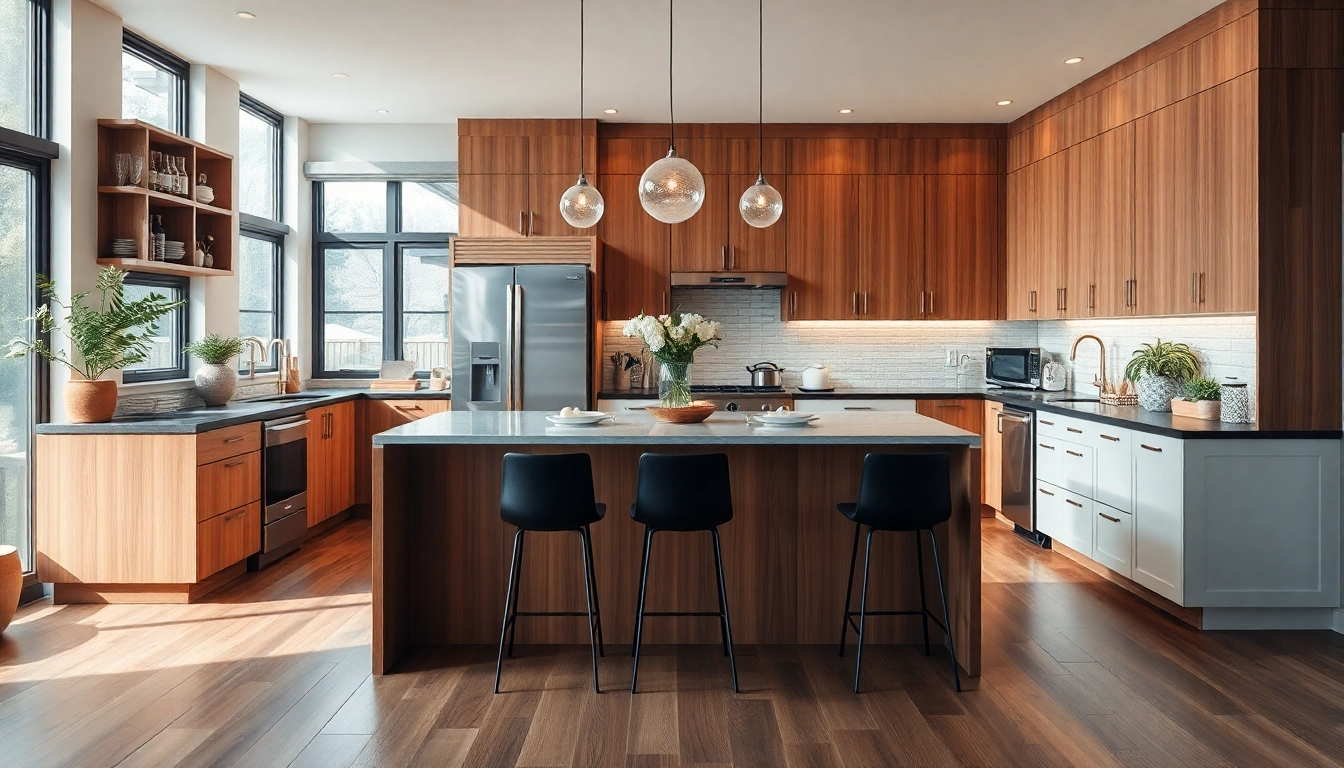Understanding Kitchen Remodeling: An Overview
What is Kitchen Remodeling?
Kitchen remodeling is the process of improving or altering an existing kitchen to enhance its functionality, aesthetics, and overall value. This significant home improvement project can involve various changes, from updating appliances, fixtures, and countertops to reconfiguring the entire layout of the space. It represents an investment not only in your home but also in your lifestyle, fostering a kitchen environment that aligns with your cooking habits and entertaining style.
In many ways, the kitchen is the heart of a home. It serves not only as a cooking space but also as a gathering place for family and friends. Consequently, a well-thought-out remodeling project can dramatically improve not just the value of your home but also your quality of life. To embark on this journey, many homeowners seek guidance from professionals or online resources for quality kitchen remodeling insights.
Common Kitchen Remodeling Challenges
While kitchen remodeling can be an exciting endeavor, it comes with its fair share of challenges. Here are some common obstacles homeowners face:
- Budget Overruns: One of the most significant challenges is staying within budget. Costs can spiral out of control due to unexpected repairs, material upgrades, or changes in design during the project.
- Time Constraints: Kitchen remodeling projects often take longer than expected, leading to extended periods without a functional kitchen.
- Design Conflicts: Balancing style with functionality can be tricky, leading to potential design conflicts that may not meet practical needs.
- Regulatory Compliance: Navigating local building codes and obtaining necessary permits can complicate the remodeling process.
Key Benefits of Remodeling Your Kitchen
Despite these challenges, embarking on a kitchen remodel offers numerous advantages:
- Increased Home Value: A remodeled kitchen can significantly boost your property value, making it more attractive to potential buyers.
- Enhanced Safety: Upgrading outdated appliances and fixtures ensures a safer cooking environment.
- Improved Functionality: A well-planned remodel can create a more efficient workflow, making everyday tasks easier and more enjoyable.
- Personalized Space: Customizing your kitchen to fit your style can enhance your enjoyment of the space.
Essential Steps in Your Kitchen Remodeling Journey
Planning and Budgeting for Your Kitchen Remodel
Every successful kitchen remodel begins with careful planning and budgeting. Define your project’s scope and determine how much you’re willing to spend. Create a detailed budget that includes:
- Materials (cabinets, countertops, flooring)
- Labor costs
- Potential contingency funds for unexpected expenses
Use online resources or consult with professionals as necessary. Tools such as kitchen estimators can help you get a rough estimate of your remodeling costs, allowing you to plan realistically.
Choosing the Right Materials for Your Kitchen
The materials you select for your kitchen remodel can significantly impact both functionality and aesthetics. Here are some key factors to consider:
- Durability: Choose materials that can withstand daily wear and tear. For example, quartz and granite are popular for countertops due to their durability and low maintenance.
- Aesthetics: Consider how the materials will complement the overall design of your kitchen. Look for colors and finishes that inspire you.
- Budget: Some materials are more expensive than others. Be sure to weigh cost against features when making choices.
Ultimately, your choices should reflect both your personal taste and the functional needs of your kitchen.
Hiring Professionals vs. DIY: Pros and Cons
Deciding whether to hire professionals or tackle a remodel yourself is often a key dilemma for homeowners. Weighing the pros and cons can help in making this decision:
- Hiring Professionals:
- Pros: Expertise, efficiency, and access to quality materials and tools. Professionals navigate regulations, permitting, and inspections seamlessly.
- Cons: Higher costs due to labor fees, and less control over project details.
- DIY:
- Pros: Cost-effectiveness, creativity in design, and the satisfaction of completing a project on your own.
- Cons: Time commitment, potential mistakes, and lack of professional-grade quality.
Ultimately, your choice should align with your skills, budget, and the scope of your project.
Innovative Kitchen Design Ideas
Captivating Color Palettes and Themes
Choosing the right color palette can set the tone for your kitchen. Popular themes include:
- Modern Minimalist: Focus on neutral colors with sleek lines and minimal clutter.
- Rustic Charm: Use earthy tones and distressed woods to create a cozy atmosphere.
- Bold Contrasts: Play with contrasts like black and white or bright accent colors against muted tones.
It’s important to choose colors that harmonize with the rest of your home and reflect your personal style.
Maximizing Space with Smart Layouts
Incorporating efficient layouts can make a small or large kitchen more functional:
- Galley Layout: Perfect for narrow kitchens, allowing for efficient use of space.
- U-Shape Layout: Provides ample storage and counter space ideal for busy cooks.
- Island Layout: Centrally located islands offer additional workspaces and promote social interaction.
Consider how your kitchen will be used daily to determine the best layout for your needs.
Integrating Technology into Kitchen Remodeling
Smart technology has a growing presence in kitchen design. Here are some innovative solutions to consider:
- Smart Appliances: Invest in appliances that offer connectivity, enabling you to control them via smartphone.
- Touchless Faucets: These improve hygiene while providing ease of use.
- Ambient Lighting: Install smart lighting systems that adjust color and brightness based on the time of day or cooking activities.
Integrating these features can enhance both functionality and convenience in your space.
Finishing Touches for a Successful Kitchen Remodel
Effective Lighting Solutions for Modern Kitchens
Lighting is a crucial element in any kitchen remodel. Effective lighting solutions can enhance aesthetics while improving functionality:
- Task Lighting: Focused lighting for food prep areas, such as under-cabinet lighting.
- Ambient Lighting: General overhead lighting that sets the mood and provides illumination.
- Accent Lighting: Highlight architectural features or décor items to add visual interest.
Incorporating a mix of lighting styles can create an inviting and efficient workspace.
Stylish Storage Options to Enhance Functionality
Storage solutions can significantly enhance kitchen functionality. Consider the following stylish options:
- Pull-Out Shelves: These maximize deep cabinet spaces and improve accessibility.
- Hanging Racks: Great for pots, pans, or herbs, adding both style and practical storage.
- Drawer Dividers: Keep utensils and tools organized, making every item easy to find.
Choose storage that complements your kitchen’s design, ensuring that it remains stylish as well as functional.
Final Inspection: Ensuring Quality and Satisfaction
After completing your remodel, take the time to conduct a thorough inspection. Assess all work for quality, ensuring every aspect meets your expectations. Check for:
- Functionality of appliances and fixtures
- Quality of finishes and workmanship
- Overall aesthetic appeal
If any issues arise, address them promptly to guarantee satisfaction with your newly remodeled kitchen.
Measuring Success: Kitchen Remodeling Performance Metrics
Evaluating the ROI of Your Kitchen Remodeling
Understanding the return on investment (ROI) is essential for measuring your remodel’s success. Research has shown that kitchen remodels can yield an ROI of around 60-80%, making it one of the most valuable home improvement projects. Factors influencing ROI include:
- Quality of materials selected
- Extent of the remodel (minor vs. major)
- Current market conditions
To maximize your ROI, focus on appealing to future buyers while incorporating personal preferences.
Tips for Maintaining Your Remodeled Kitchen
Once your remodel is complete, maintaining the space is vital for longevity. Here are some maintenance tips:
- Regularly clean surfaces to prevent stains and damage.
- Inspect appliances for wear and tear and perform routine maintenance.
- Inspect seals and caulking around sinks and counters to prevent water damage.
Routine care helps ensure that your kitchen remains a beautiful and functional space for years to come.
Gathering Feedback: A Key to Future Projects
Gathering feedback, whether from friends, family, or even a real estate agent, can provide insight into how well your remodel meets functional and aesthetic needs. Reflect on:
- What elements are most appreciated?
- What would you change if given the chance?
- How does the remodeled kitchen impact your daily life?
These reflections can inform any future remodeling projects, allowing for continuous improvement and satisfaction.









